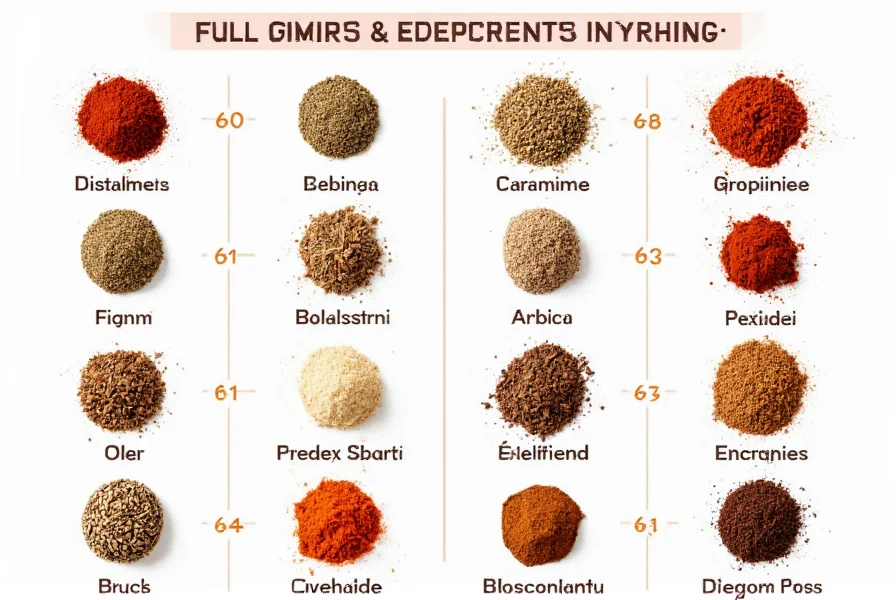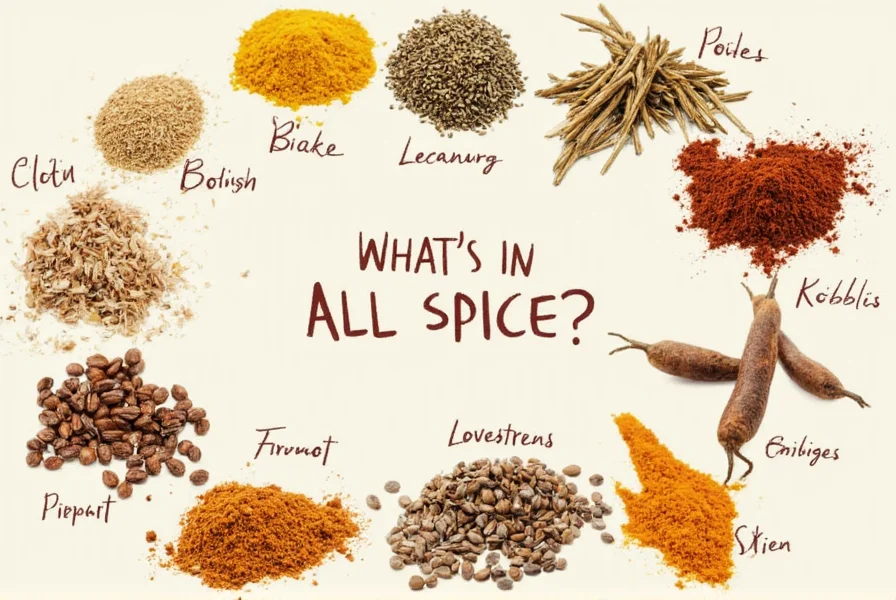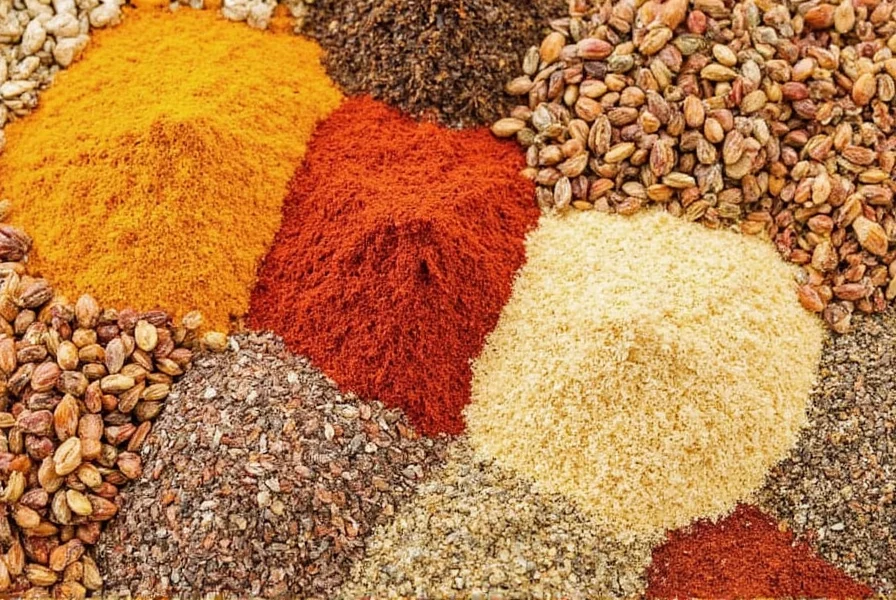When home cooks and professional chefs search for whats in all spice, they're seeking clarity about this versatile seasoning blend that often causes confusion. Unlike single-ingredient allspice (which comes from the Pimenta dioica plant), all spice refers to a pre-mixed combination of multiple spices designed to simplify cooking processes.
Understanding All Spice Composition
The term all spice can be misleading because it doesn't contain "all" spices, but rather a specific selection that works harmoniously in various recipes. This culinary blend has become increasingly popular as home cooking has evolved toward convenience without sacrificing flavor complexity.
Core Ingredients in Traditional All Spice Blends
While formulations differ slightly between brands and regions, most commercial and homemade all spice blends contain these essential components:
| Spice | Typical Percentage | Flavor Contribution |
|---|---|---|
| Cinnamon | 30-40% | Warm sweetness, subtle heat |
| Cloves | 20-25% | Intense aromatic, slightly bitter |
| Nutmeg | 15-20% | Earthy, nutty, slightly sweet |
| Allspice (Pimento) | 10-15% | Complex blend of cinnamon, cloves, nutmeg flavors |
| Ginger | 5-10% | Subtle heat, citrus notes |
This precise balance creates a seasoning that delivers multiple flavor dimensions simultaneously, making it valuable for recipes requiring layered spice profiles without measuring numerous individual spices.

Regional Variations of All Spice Mixtures
Understanding what's included in all spice requires recognizing regional differences that affect composition:
- American all spice blends typically emphasize cinnamon and nutmeg with moderate cloves
- British mixed spice contains more coriander and caraway, with less ginger
- Caribbean all spice mixtures feature higher allspice (pimento) content with additional chili elements
- Middle Eastern baharat versions include black pepper and sometimes dried lime
These regional adaptations demonstrate how the basic all spice formula has evolved to complement local cuisines while maintaining its core identity as a multi-spice seasoning solution.
Clearing Up the Allspice Confusion
One of the most common points of confusion when searching whats in all spice is distinguishing between:
- Allspice (single word) - The dried berry of the Pimenta dioica tree, which naturally tastes like a combination of cinnamon, cloves, and nutmeg
- All spice (two words) - The pre-mixed blend of multiple spices described in this article
This linguistic distinction explains why many people searching for information about all spice blends initially receive results about the single-ingredient allspice. Understanding this difference is crucial when following recipes or purchasing the correct product.
Practical Culinary Applications
Knowing what ingredients are in all spice helps home cooks utilize this blend effectively:
- Baking applications - Use in gingerbread, pumpkin pies, and spice cakes (typically 1-2 teaspoons per recipe)
- Meat rubs - Combine with salt and pepper for pork, chicken, or lamb (2-3 tablespoons per pound of meat)
- Vegetable seasoning - Toss with root vegetables before roasting (1 teaspoon per pound of vegetables)
- Breakfast dishes - Sprinkle on oatmeal or add to pancake batter for warm flavor notes
Professional chefs often adjust the amount based on whether they're using commercial blends or homemade versions, as concentration levels vary between products.

Creating Your Own All Spice Blend
For those interested in what's really in all spice without commercial additives, making your own blend offers complete control over ingredients and freshness:
- Combine 4 tablespoons ground cinnamon
- Add 2 tablespoons ground cloves
- Mix in 1.5 tablespoons ground nutmeg
- Incorporate 1 tablespoon ground allspice (pimento)
- Stir in 0.5 tablespoons ground ginger
- Store in an airtight container away from light and heat
This homemade version avoids the anti-caking agents and preservatives sometimes found in commercial blends while providing superior flavor intensity. For optimal freshness, use within 3-4 months and store in a cool, dark place.
Storage Recommendations for Maximum Flavor
Understanding what's included in all spice extends to proper storage techniques that preserve flavor compounds:
- Store in airtight glass containers rather than plastic (which can absorb flavors)
- Keep away from heat sources like stoves or ovens
- Avoid direct sunlight which degrades essential oils
- Do not store above 70°F (21°C) for extended periods
- Replace commercial blends after 6 months for optimal flavor
Properly stored all spice maintains its complex flavor profile longer than individual ground spices due to the synergistic effects between components. However, like all ground spices, it gradually loses potency over time.
Common Questions About All Spice Blends
What's the difference between allspice and all spice?
Allspice (one word) refers to the single spice derived from the dried berries of the Pimenta dioica plant, which naturally combines flavors reminiscent of cinnamon, cloves, and nutmeg. All spice (two words) describes a pre-mixed blend of multiple spices, typically including cinnamon, cloves, nutmeg, allspice, and ginger. This distinction is crucial when following recipes or purchasing the correct product.
Can I substitute individual spices for all spice in recipes?
Yes, you can substitute individual spices for all spice. For each teaspoon of all spice blend, use 1/2 teaspoon cinnamon, 1/4 teaspoon ground cloves, 1/8 teaspoon nutmeg, 1/8 teaspoon allspice (pimento), and a pinch of ginger. This substitution works well in most baking and cooking applications, though the flavor profile may be slightly less complex than a professionally blended mixture.
Why does my all spice blend taste different from store to store?
All spice blends vary significantly between manufacturers due to differences in spice ratios, quality of source materials, grinding techniques, and additional ingredients. Some commercial blends include anti-caking agents or preservatives that affect flavor. Regional variations also play a role, with American blends typically heavier on cinnamon while British versions contain more coriander. This explains why the same recipe might yield different results with different brands.
Is all spice blend gluten-free and suitable for special diets?
Pure all spice blends containing only spices are naturally gluten-free, vegan, and paleo-friendly. However, some commercial products may include anti-caking agents or be processed in facilities that handle gluten-containing products. Always check labels if you have specific dietary restrictions. For complete assurance, making your own blend from individual spices guarantees no unwanted additives.
How can I tell if my all spice blend has gone bad?
Signs that your all spice blend has lost potency include faded color, diminished aroma (should smell robustly spicy when fresh), and lack of flavor impact in recipes. Properly stored, commercial blends maintain quality for 6-12 months, while homemade versions last 3-4 months. If you need to use more than double the recommended amount to achieve flavor, it's time to replace your blend.











 浙公网安备
33010002000092号
浙公网安备
33010002000092号 浙B2-20120091-4
浙B2-20120091-4